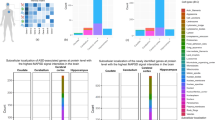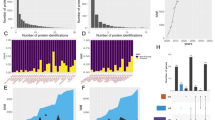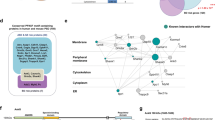Abstract
The postsynaptic density (PSD) contains a collection of scaffold proteins used for assembling synaptic signaling complexes. However, it is not known how the core-scaffold machinery associates in protein-interaction networks or how proteins encoded by genes involved in complex brain disorders are distributed through spatiotemporal protein complexes. Here using immunopurification, proteomics and bioinformatics, we isolated 2,876 proteins across 41 in vivo interactomes and determined their protein domain composition, correlation to gene expression levels and developmental integration to the PSD. We defined clusters for enrichment of schizophrenia, autism spectrum disorders, developmental delay and intellectual disability risk factors at embryonic day 14 and adult PSD in mice. Mutations in highly connected nodes alter protein–protein interactions modulating macromolecular complexes enriched in disease risk candidates. These results were integrated into a software platform, Synaptic Protein/Pathways Resource (SyPPRes), enabling the prioritization of disease risk factors and their placement within synaptic protein interaction networks.
This is a preview of subscription content, access via your institution
Access options
Access Nature and 54 other Nature Portfolio journals
Get Nature+, our best-value online-access subscription
$29.99 / 30 days
cancel any time
Subscribe to this journal
Receive 12 print issues and online access
$209.00 per year
only $17.42 per issue
Buy this article
- Purchase on Springer Link
- Instant access to full article PDF
Prices may be subject to local taxes which are calculated during checkout







Similar content being viewed by others
References
Bayés, A. et al. Characterization of the proteome, diseases and evolution of the human postsynaptic density. Nat. Neurosci. 14, 19–21 (2011).
Collins, M.O. et al. Molecular characterization and comparison of the components and multiprotein complexes in the postsynaptic proteome. J. Neurochem. 97 (Suppl. 1), 16–23 (2006).
Coba, M.P. et al. Neurotransmitters drive combinatorial multistate postsynaptic density networks. Sci. Signal. 2, ra19 (2009).
Collins, M.O. et al. Proteomic analysis of in vivo phosphorylated synaptic proteins. J. Biol. Chem. 280, 5972–5982 (2005).
Husi, H., Ward, M.A., Choudhary, J.S., Blackstock, W.P. & Grant, S.G. Proteomic analysis of NMDA receptor-adhesion protein signaling complexes. Nat. Neurosci. 3, 661–669 (2000).
Pawson, T. & Scott, J.D. Signaling through scaffold, anchoring, and adaptor proteins. Science 278, 2075–2080 (1997).
Scott, J.D. & Pawson, T. Cell signaling in space and time: where proteins come together and when they're apart. Science 326, 1220–1224 (2009).
Sheng, M. & Kim, E. The postsynaptic organization of synapses. Cold Spring Harb. Perspect. Biol. 3, a005678 (2011).
Kornau, H.C., Schenker, L.T., Kennedy, M.B. & Seeburg, P.H. Domain interaction between NMDA receptor subunits and the postsynaptic density protein PSD-95. Science 269, 1737–1740 (1995).
Fernández, E. et al. Targeted tandem affinity purification of PSD-95 recovers core postsynaptic complexes and schizophrenia susceptibility proteins. Mol. Syst. Biol. 5, 269 (2009).
Kim, E. et al. GKAP, a novel synaptic protein that interacts with the guanylate kinase-like domain of the PSD-95/SAP90 family of channel clustering molecules. J. Cell Biol. 136, 669–678 (1997).
Naisbitt, S. et al. Shank, a novel family of postsynaptic density proteins that binds to the NMDA receptor/PSD-95/GKAP complex and cortactin. Neuron 23, 569–582 (1999).
Vinade, L. et al. Affinity purification of PSD-95-containing postsynaptic complexes. J. Neurochem. 87, 1255–1261 (2003).
Grant, S.G. Synaptopathies: diseases of the synaptome. Curr. Opin. Neurobiol. 22, 522–529 (2012).
Stark, C. et al. BioGRID: a general repository for interaction datasets. Nucleic Acids Res. 34, D535–D539 (2006).
Calderone, A., Castagnoli, L. & Cesareni, G. Mentha: a resource for browsing integrated protein-interaction networks. Nat. Methods 10, 690–691 (2013).
Börnigen, D. et al. Concordance of gene expression in human protein complexes reveals tissue specificity and pathology. Nucleic Acids Res. 41, e171 (2013).
Taylor, I.W. et al. Dynamic modularity in protein interaction networks predicts breast cancer outcome. Nat. Biotechnol. 27, 199–204 (2009).
Bossi, A. & Lehner, B. Tissue specificity and the human protein interaction network. Mol. Syst. Biol. 5, 260 (2009).
Jin, J. et al. Eukaryotic protein domains as functional units of cellular evolution. Sci. Signal. 2, ra76 (2009).
Letunic, I., Doerks, T. & Bork, P. SMART: recent updates, new developments and status in 2015. Nucleic Acids Res. 43, D257–D260 (2015).
Finn, R.D. et al. Pfam: the protein families database. Nucleic Acids Res. 42, D222–D230 (2014).
Fromer, M. et al. De novo mutations in schizophrenia implicate synaptic networks. Nature 506, 179–184 (2014).
Georgieva, L. et al. De novo CNVs in bipolar affective disorder and schizophrenia. Hum. Mol. Genet. 23, 6677–6683 (2014).
Kirov, G. et al. Support for the involvement of large copy number variants in the pathogenesis of schizophrenia. Hum. Mol. Genet. 18, 1497–1503 (2009).
Kirov, G. et al. De novo CNV analysis implicates specific abnormalities of postsynaptic signalling complexes in the pathogenesis of schizophrenia. Mol. Psychiatry 17, 142–153 (2012).
Pinto, D. et al. Convergence of genes and cellular pathways dysregulated in autism spectrum disorders. Am. J. Hum. Genet. 94, 677–694 (2014).
State, M.W. & Levitt, P. The conundrums of understanding genetic risks for autism spectrum disorders. Nat. Neurosci. 14, 1499–1506 (2011).
Pavlowsky, A., Chelly, J. & Billuart, P. Emerging major synaptic signaling pathways involved in intellectual disability. Mol. Psychiatry 17, 682–693 (2012).
Xie, Z. et al. Receptor tyrosine kinase MET interactome and neurodevelopmental disorder partners at the developing synapse. Biol. Psychiatry 80, 933–942 (2016).
Endele, S. et al. Mutations in GRIN2A and GRIN2B encoding regulatory subunits of NMDA receptors cause variable neurodevelopmental phenotypes. Nat. Genet. 42, 1021–1026 (2010).
Genovese, G. et al. Increased burden of ultra-rare protein-altering variants among 4,877 individuals with schizophrenia. Nat. Neurosci. 19, 1433–1441 (2016).
Schizophrenia Working Group of the Psychiatric Genomics Consortium. Biological insights from 108 schizophrenia-associated genetic loci. Nature 511, 421–427 (2014).
Zybailov, B. et al. Statistical analysis of membrane proteome expression changes in Saccharomyces cerevisiae. J. Proteome Res. 5, 2339–2347 (2006).
Yang, H., Robinson, P.N. & Wang, K. Phenolyzer: phenotype-based prioritization of candidate genes for human diseases. Nat. Methods 12, 841–843 (2015).
Purcell, S.M. et al. A polygenic burden of rare disruptive mutations in schizophrenia. Nature 506, 185–190 (2014).
Li, J. et al. Long-term potentiation modulates synaptic phosphorylation networks and reshapes the structure of the postsynaptic interactome. Sci. Signal. 9, rs8 (2016).
O'Roak, B.J. et al. Exome sequencing in sporadic autism spectrum disorders identifies severe de novo mutations. Nat. Genet. 43, 585–589 (2011).
Peça, J. & Feng, G. Cellular and synaptic network defects in autism. Curr. Opin. Neurobiol. 22, 866–872 (2012).
Pinto, D. et al. Functional impact of global rare copy number variation in autism spectrum disorders. Nature 466, 368–372 (2010).
Mattheisen, M. et al. Genome-wide association study in obsessive-compulsive disorder: results from the OCGAS. Mol. Psychiatry 20, 337–344 (2015).
Elia, J. et al. Genome-wide copy number variation study associates metabotropic glutamate receptor gene networks with attention deficit hyperactivity disorder. Nat. Genet. 44, 78–84 (2011).
Walsh, T. et al. Rare structural variants disrupt multiple genes in neurodevelopmental pathways in schizophrenia. Science 320, 539–543 (2008).
Basu, M.K., Carmel, L., Rogozin, I.B. & Koonin, E.V. Evolution of protein domain promiscuity in eukaryotes. Genome Res. 18, 449–461 (2008).
Carter, H., Hofree, M. & Ideker, T. Genotype to phenotype via network analysis. Curr. Opin. Genet. Dev. 23, 611–621 (2013).
Shannon, P. et al. Cytoscape: a software environment for integrated models of biomolecular interaction networks. Genome Res. 13, 2498–2504 (2003).
Arbuckle, M.I. et al. The SH3 domain of postsynaptic density 95 mediates inflammatory pain through phosphatidylinositol-3-kinase recruitment. EMBO Rep. 11, 473–478 (2010).
De Rubeis, S. et al. CYFIP1 coordinates mRNA translation and cytoskeleton remodeling to ensure proper dendritic spine formation. Neuron 79, 1169–1182 (2013).
McLaren, W. et al. Deriving the consequences of genomic variants with the Ensembl API and SNP Effect Predictor. Bioinformatics 26, 2069–2070 (2010).
Kosmicki, J.A. et al. Refining the role of de novo protein-truncating variants in neurodevelopmental disorders by using population reference samples. Nat. Genet. 49, 504–510 (2017).
Samocha, K.E. et al. A framework for the interpretation of de novo mutation in human disease. Nat. Genet. 46, 944–950 (2014).
Coba, M.P. et al. TNiK is required for postsynaptic and nuclear signaling pathways and cognitive function. J. Neurosci. 32, 13987–13999 (2012).
Cuthbert, P.C. et al. Synapse-associated protein 102/dlgh3 couples the NMDA receptor to specific plasticity pathways and learning strategies. J. Neurosci. 27, 2673–2682 (2007).
Acknowledgements
This work was supported by grants from the National Institute of Child Health and Human Development (MH104603-01A1 to M.P.C.), NIH grant MH108728 (to K.W. and H.Y.), Simons Foundation Autism Research Initiative (SFARI) grants 248429 and 345034, and DOD CDMRP AR110189 (to T.A.). B.N. acknowledges support from the Stanley Center for Psychiatric Research.
Author information
Authors and Affiliations
Contributions
J.L., W.Z., B.W., V.A.C., J.C.T. and M.P.C. performed experiments; J.L., W.Z., B.W., H.Y., T.S., O.V.E., D.P.H. and G.G. performed analysis; T.A., J.A.K., K.W., B.M.N., F.S. and M.P.C. supervised analysis; F.S., K.W. and M.P.C. designed experiments and analysis; J.L., B.W., F.S. and M.P.C. and wrote the manuscript; M.P.C. supervised the project.
Corresponding author
Ethics declarations
Competing interests
The authors declare no competing financial interests.
Integrated supplementary information
Supplementary Figure 1 Reported (nonredundant) protein interactions in PSD scaffold complexes
Comparison of Dlg4, Dlgap1 and Shank3 protein interactions isolated by HPLC-MS/MS compared to interactions reported in the BioGRID15 and Mentha16 protein-protein interaction databases. Heatmap shows comparison to e14/p7/p14/adult redundant interactions without discrimination between developmental stage
Supplementary Figure 2 Assay classification of reported protein–protein interactions.
Figure illustrates the distribution of the methods used to characterize previously reported protein-protein interactions that are also reported in the current study. The methods include those that show direct protein-protein interactions (yeast two-hybrid and co-crystallization) and indirect protein-protein interactions (co-fractionation, affinity capture followed by mass spectrometry, affinity capture followed by western blot, reconstituted complex, co-localization, co-purification, and far-western blotting). Each previously reported interaction listed in supplementary table 2 was annotated as being shown by direct methods, indirect methods, or both where applicable. Detection methods are separated by the corresponding species in which the protein-protein interaction was shown as in A) All species combined, B) Homo sapiens, C) Mus musculus, and D) Rattus Norvegicus.
Supplementary Figure 3 Reported (nonredundant) protein interactions in PSD scaffold interactors complexes
Comparison of scaffold interactomes isolated by HPLC-MS/MS compared to interactions reported in the BioGRID15 and Mentha16 protein-protein interaction databases for interactions at different developmental stages and spatial localization (top, redundant) and interactions without any discrimination between developmental stage or cellular localization (bottom, non-redundant).
Supplementary Figure 4 Protein content analysis
Protein content in Tnik−/− and Shank3ΔC−/+ mice.
Quantitation of total protein content for protein interactions determined by MS (Figure 7) in mouse PFC. Representative cropped images of WB from four independent experiments which were analyzed using the unpaired t-test. All data represented as mean ± s.e.m.
Supplementary information
Supplementary Text and Figures
Supplementary Figures 1–4 and Supplementary Datasets 1 and 2 (PDF 9122 kb)
Supplementary Table 1
Interactomes dataset Tab 1 (PSD Scaffolds) Protein interactions identified in MS analysis of protein complexes from PSD scaffolds (Dlg4, Dlgap1, Shank3) All protein interactors have no less than 2 peptides identified together in at least triplicate samples by MASCOT and SEQUEST, and are not present in negative control purifications. Column A: Developmental stage/Cellular localization/Cell type Column B: Target Protein Column C Protein interaction (Gene name) Supplementary table contains interactomes of the PSD scaffolding proteins (sheet 1) and PSD scaffold-interactors (sheet 2) described in the main text. Developmental stage/localization column describes at what developmental stage the immunopurification was performed and whether it was with PSD or non-PSD fractions. Tab 2 (Scaffold interactors) Protein interactions identified in MS analysis of protein complexes from PSD proteins that are scaffold interactors All protein interactors have no less than 2 peptides identified together in at least triplicate samples by MASCOT and SEQUEST, and are not present in negative control purifications. Column A: Developmental stage/Cellular localization/Cell type Column B: Target Protein Column C Protein interaction (Gene name) The protein column contains the target protein used for immunopurification while the Interactor columns contain the interactors of that particular protein identified via mass spectrometry with the corresponding mouse, human, or rat annotation corresponding gene symbol according to the Entrez Gene Database.The Mentha and Biogrid columns contain a yes if that particular interaction was reported in the protein-protein interaction databases for the corresponding species Tab 3 Annotations for all protein interactions identified in MS assays A: Interactor gene name B: Cytogenetic location C: Genomic coordinates (GRCh37)D: HUGO Gene Nomenclature Committee (HGNC) id E: Mouse Genome Informatics (MGI) id F-H: Online Mendelian Inheritance in Man (OMIM) annotation (XLSX 375 kb)
Supplementary Table 2
Reported interactions dataset Supplementary table contains previously reported protein-protein interactions overlapping with the current dataset. With a majority of previously reported interactions being derived from BioGRID (release 3.4.142) the table contains the BioGRID-specifc identifiers such as BioGRID interaction and organism ID. Organism ID corresponds to: Homo sapiens = 9606, Mus Musculus = 10090, Rattus norvegicus = 10116. Table also contains Entrez Gene Database identifiers, official gene symbols, reference pubmed ID, and the experimental system for each previously reported interaction. (XLSX 58 kb)
Supplementary Table 3
Protein domain analysis of interactomes Proteins isolated by HPLC-MS/MS from mouse PFC Column A: Gene ID Column B: MGI ID Column C: Description Protein domain composition of PSD Proteins (SMART/Pfam databases) Column A: Database Column B: Domain ID Column C: Number of PSD proteins with domain Column D: p-value Column E: Gene IDs with domains Column F: Total number of domains Column G: Total-Database Column H: Enrichment Column I: Correction (Bonferroni) Column J: False Discovery Rate (XLSX 126 kb)
Supplementary Table 4
Protein domain annotation and enrichment for developmental scaffold protein complexes Individual protein complexes are shown in separate spreadsheets Column A: Domain ID (SMART/Pfam) Column B: Domain name Column C: Number of proteins containing the domain in the protein complex Column D: p-value Column E: Corrected p-value (Bonferroni) (XLSX 48 kb)
Supplementary Table 5
Clustering of developmental Dlg4/Dlgap1/Shank3 protein complexes Node name and network parameters for Dlg4, Dlgap1 and Shank3 (e14, p7, p14 adult) protein complexes. Network parameters include: number of nodes, average degree (average connectivity of a node in the network), network density (normalize average connectivity of each node), clustering coefficient (ratio of N / M, where N is the number of edges between the neighbors of this node, and M is the maximum number of edges that could possibly exist between the neighbors of the node), clustering coefficient of a node is always a number between 0 and 1.The network clustering coefficient is the average of the clustering coefficients for all nodes in the network. Here, nodes with less than two neighbors are assumed to have a clustering coefficient of 0. (XLSX 94 kb)
Supplementary Table 6
Protein domain annotation and enrichment for scaffold interactors protein complexes Individual protein complexes are shown in separate spreadsheets Column A: Domain ID (SMART/Pfam) Column B: Domain name Column C: Number of proteins containing the domain in the protein complex Column D: p-value Column E: Corrected p-value (Bonferroni) (XLSX 80 kb)
Supplementary Table 7
Testing for gene set enrichment among de novo mutations in brain disorders Individual spreadsheets indicate datasets, description and analysis: SCZ, ASD, DD, ID, SIB_CONTROL, CHD-NS, CHD-S. (XLSX 132 kb)
Supplementary Table 8
Clustering of Adult PSD protein complexes Dataset includes: Tnik, Dlg4, Dlgap1, Shank3, Tsc1, Homer1, Nckap1, Cyfip1, Cyfip2, Syngap1, Fmr1, Cnksr2 nodes Columns A-N: Node name and network parameters Columns O-Q: Disrupted interactions in MAGUK protein complexes with Tnik−/− mutation. Columns R-T: Disrupted interactions in Dlgap1 protein complexes with Tnik−/− mutation. Columns U-W: Disrupted interactions in Shank3 protein complexes with Tnik−/− mutation. Columns X-Z: Disrupted interactions in Dlgap1 protein complexes with Shank3ΔC−/+ mutation Columns AA-AC: Disrupted interactions in Shank3 protein complexes with Shank3ΔC−/+ mutation All protein interactions were determined in triplicate samples. Normalized spectral abundance factor (NSAF) was calculated for each protein34, 54 and used for comparison between wt/mutant samples. Table shows disruption of highly connected nodes. Tnik and Shank3 spreadsheets, shows quantitation of total protein levels by WB analysis of PSD proteins with impaired associations to PSD protein complexes in wt and Tnik−/−, Shank3ΔC/+ mice. Columns D and E shows ratios wt/mutant mice rations and standard deviation for triplicate assays. Protein ratios did not present statistical significance (0.66/1.5 p<0.05). Bottom tables shows exact p values for quantitation of protein interactions in scaffold complexes by western blot assays (XLSX 95 kb)
Supplementary Table 9
Non-specific proteins determined by MS. Column A: Uniprot id, Column B: Gene name (XLSX 10 kb)
Supplementary Table 10
Non-specific RNA binding proteins determined by MS. Table shows RNA binding proteins determined by MS in samples treated with RNAse T1/A. Column A: Uniprot id, Column B: Gene name (XLSX 41 kb)
Supplementary Table 11
Antibodies used in IP, and WB assays (XLSX 51 kb)
Rights and permissions
About this article
Cite this article
Li, J., Zhang, W., Yang, H. et al. Spatiotemporal profile of postsynaptic interactomes integrates components of complex brain disorders. Nat Neurosci 20, 1150–1161 (2017). https://doi.org/10.1038/nn.4594
Received:
Accepted:
Published:
Issue Date:
DOI: https://doi.org/10.1038/nn.4594
This article is cited by
-
Systematic HOIP interactome profiling reveals critical roles of linear ubiquitination in tissue homeostasis
Nature Communications (2024)
-
Remodeling of the postsynaptic proteome in male mice and marmosets during synapse development
Nature Communications (2024)
-
Non-synaptic function of the autism spectrum disorder-associated gene SYNGAP1 in cortical neurogenesis
Nature Neuroscience (2023)
-
A cross-species proteomic map reveals neoteny of human synapse development
Nature (2023)
-
The dark side of synaptic proteins in tumours
British Journal of Cancer (2022)



